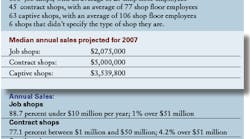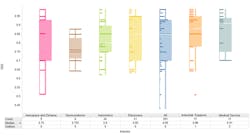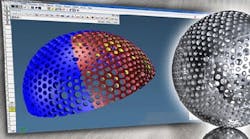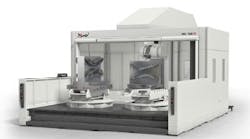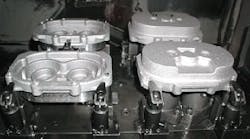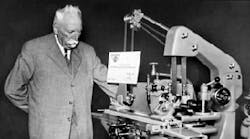By Bruce Vernyi and Lawrence Haftl
American Machinist has conducted its second annual survey of machine shops to gather information our readers need to accurately gage their competitive positions in the industry, and to help them make plans that will enable them to systematically improve their operations and become more competitive.
We have identified key indicators and best practices that lead to improved productivity and profitability and, with the responses to questions about those indicators and best practices, we are able to identify a set of shops whose performance puts them in the lead of all the shops surveyed.
That group of shops is our benchmark set, and represents the top 20 percent of shops that responded to the survey. The results for the Benchmark shops are composites, so they do not represent one shop's performance, but the combined performance from all the best shops. We believe these performance results and the practices that lead to them provide targets that all shops can strive to reach, and they provide performance measurements to which all shops can compare themselves to check their current competitive positions and their progress in reaching higher degrees of efficiency.
To analyze the survey data, we summarized the data for all shops, and compared that data to the information on the Benchmark shops percent.
For example, on an overall basis, 74 percent of the shops that responded to our survey said they are independent and 26 percent are part of a larger company. For the benchmark shops, 83.3 percent are independent, and 16.7 percent are part of a larger company.
We also tabulated the data by the type of shop; whether they are job shops, contract shops or captive shops; and we tabulated the data by employment levels, to compare companies with 1 to 20 employees, companies with 21 to 50 employees and companies with more than 50 employees.
We grouped the survey questions into the following categories: Profile information, human resources, strategy and operations, inventories, capital equipment, supply chain and information technology, and we will be providing analyses of data based on those different groupings in the coming months. For anyone who is eager to see the raw data, we will post that entire set of numbers on our internet site, (www.americanmachinist.com). The data will be posted under the "community" hot button near the top of the web page in a drop-down menu by July 15.
Given the number of questions, we estimated that it required nearly an hour to fill out our survey. The responses provide useful data, from which several factors stand out.
The amount of money shops spend on tooling per year is one of the stand-out statistics that separate the benchmark shops from all of the others. Shops in the benchmark set spend $92,500 a year (the median spending level, according to the survey), while the median for all shops is $47,500 and the median for shops that are not in the benchmark group is only $30,000 a year. So, benchmark shops spend three times as much on tooling each year as all other shops do.
Then, if we look at total output (the number of units produced each year) we find that the median number of production units for benchmark shops is 90,725 while median number of production units for all other shops is 5,000. That means that benchmark shops are able to produce 18 times the number of parts that all other shops do while spending only three times the cost on tooling. So, it is obvious that benchmark shops are getting a lot more parts for the money they spend on tooling.
In the example, we used median values rather than averages because it only takes one or two very large responses to a question to distort the information. Medians are the actual values of the survey response in the middle of all responses when the responses are sorted. We believe that medians are usually more representative of true average values than the "average" is when there are just a few very large responses. Have your eyes glazed over yet?
Analyzing all of the data the survey provides can be a mind-numbing proposition. Rather than providing page after page of data here, we are breaking the data into bite-sized chunks organized by topic, and into several articles in our attempt to turn the mountain of raw data into gems of useful information.
In this issue we look at the functions and practices that noticeably set the benchmark group of shops apart from the rest, and we are paying particular attention to responses where the benchmark shops differed from the other shops by a factor of two to one or more. In later issues we will drill down into the data to review the information on a topic-by-topic basis.
PROFILES
One indication of a business' health is its return on invested capital. That return is defined as the shop's net operating profit after taxes divided by the capital it has invested, and indicates how well a shop uses the tools and equipment it has purchased. Benchmark shops got a median return during the current year of 20 percent while other shops have a median return of 10 percent. Both the benchmark shops and the other shops increased their returns on invested capital from three years ago, with the benchmark shops making a 10 percent improvement, and other shops making a 6 percent improvement in this fundamental area.
Additionally, there are significant differences in the primary industries that shops serve, and this comes as little surprise. The greatest number of shops that provide precision machining and machining services for the aerospace industry are among the leading shops. This is not a surprise because it stands to reason that shops that pursue those markets perform at the top end of the industry.
HUMAN RESOURCES
The benchmark shops tend to have more employees than other shops, and they tend to offer higher incentive packages that include bonus plans, apprentice, leadership development and training programs, and shop-paid medical benefits.
The median number of shop floor employees follows the pattern of employment, with benchmark shops reporting a median number of 29 employees on their shop floors, compared with 11 shop floor employees at other shops. Also, benchmark shops report that they provide more hours per year for employee training, and allow their shop-floor personnel to make a greater number of operating decisions than other shops. Nonetheless, the reported per-hour pay scales between the benchmark shops and all other shops is about the same. Both reported median per-hour wages of $16 for machine operators, and benchmark shops reported that they pay set-up personnel $20 per hour, while other shops said they pay set-up personnel $19 per hour.
One of the surprising results from the survey is the unconcealed level of self-esteem that shops that are not among the benchmark group appears to have for themselves: 77.5 percent of those shops – the ones outside of the benchmark group – said they believe their operations have made progress toward or already are "world-class" machining operations.
Despite that, the shops in the benchmark group said they are deriving more of their sales from outside the United States than they did three years ago, while all of the other shops said they see less than 1 percent of their sales from off-shore sources.
PROCESSES AND PRODUCTION
Several areas stood out among the processes that shops use when we compared the benchmark shops to all other shops in the survey. The leading shops plan to spend more of their annual revenues to purchase capital equipment, they use multitasking processes far more than other shops, and they have a significant advantage in the uses of laser cutting and water-jet cutting technologies. However, in regards to the use of other machining processes such as milling and turning, tapping and threading, boring, drilling and reaming, sawing and grinding, there were only minor differences between the leading shops and the other shops. The median levels of capital-equipment spending for the benchmark shops, as a percentage of sales, is 8.0 percent compared to 5.0 percent for other shops. As noted earlier, median return on invested capital is 20.0 percent for benchmark shops and only 10.0 percent for other shops.
Additionally, among shops that use multitasking, significant differences popped up in the uses of multiple live tools and in the use of multispindle machines, while techniques such as mill/ turning, hard-turning and hard milling were used by all. However, the leading shops are far ahead in using cellular manufacturing and automation, computer-aided design and manufacturing, statistical process control, robotics and advanced tools such as on-machine monitors. Benchmark shops are also substantially ahead of the other shops in using CAM and 3D CAD systems that offer substantial productivity improvements for only modest investments.
The diversity of tools helps the benchmark shops to maintain a higher mix of products on their production runs whether the production quantities are high or low, survey respondents said.
It is impossible to attend a manufacturing conference or pick up any publication serving the manufacturing industry without hearing or reading about the need for, and benefits of, organized continuous-improvement programs. Therefore, it is surprising to see that more than one quarter of the other shops had no such program in place at all. Only 3.6 percent of the benchmark shops had no such program in places, while the percentage of benchmark shops that did have formal continuous-improvement programs in place is often two or three times the percentage of other shops using each of the formal improvement programs. This factor alone may account for much of the success benchmark shops achieve compared to the other shops.
The newest technologies and machine-specific techniques and production tools are in wide use in machine shops. Whether it is using fixtures that accommodate multiple workpieces or in-process measurement tools, the following practices are more frequently used by benchmark shops than by the other shops. For example, look at the line for tooling presets: 85.5 percent of the benchmark shops use tooling presets regularly, while just over half of the shops that are not in the benchmark group use tooling presets. Also, nearly half – 49.1 percent – of benchmark shops use multiple pallet changing systems while just under one-third – 30.1 percent – of all of the other shops use those systems.
However, once the capital equipment is in place, there are additional procedures that separate the benchmark shops from the others. More benchmark shops work to keep capital equipment busy and productive: 94.5 percent of the benchmark shops said they strive to maximize machine uptime, while only 70.4 percent of the other shops said they do the same, and 96.3 percent of the benchmark shops said they work on maximizing machine cutting time, while 72.0 percent of the other shops said the same.
In addition to those tools, the benchmark shops have continued to cut machining cycle time and set-up time, which helps them maximize the value they get from their capital equipment. Those actions keep machines busy and tools in-the-cut.
As a result of their efforts to maintain good production systems, benchmark shops said they see just 1.0 percent scrap and rework, as a percentage of their shop sales, compared to a rate of 3 percent for other shops. Three years ago the benchmark shops said they saw scrap and rework rates of 3.0 percent, while the other shops said they saw rates of 5.0 percent.
COSTS AND PROFIT
All shops are under pressure from rising costs and demands from customers to keep their prices down. One of the areas that benchmark shops report doing well is in maintaining low per-unit manufacturing costs. Over the past year, per-unit costs decreased for the majority of benchmark shops while they increased for other shops.
Meanwhile, benchmark shops were able to push their net profit to a median number of 14.9 percent, compared with 12 percent for other shops. That is partly based on a higher shop revenue per man hour – the amount of revenue that a shop takes in after its total labor costs are discounted. The benchmark shops said they see about $9 more per man hour in shop revenues than the other shops, based on the median numbers they reported.
As we said in the beginning, American Machinist has conducted its second annual benchmarking survey to gather information our readers need to accurately gage their competitive positions in the industry, and to help them make plans that will enable them to systematically improve their operations and become more competitive. Because the benchmark shops, those shops in the top 20 percent of all survey respondents based on overall performance, are generally more productive, more profitable and have more resources available to them than many of the other shops, many of the other shops may not be able to achieve the levels of performance that the benchmark shops do. But, all shops can use the data from the survey to determine how they compare to other shops. Shops can see, area by area, where their current performance is close to the industry's top performers and where their current practices need improvement.
The survey data can not only help shops understand how their current performance compares to other shops, but also understand just how good is good. For example, if the best shops are averaging one percent scrap and rework then it may be a waste of resources to strive for a scrap and rework rate of less than one percent. Knowing what the best shops are able to achieve provides clear and realistic targets that shops can incorporate into their own continuous-improvement programs.
In today's competitive world, working to continuously improve your competitive position is the best action you can take to continuously have a competitive position. You can use the survey data to benchmark your operation, to identify those areas where your shop's performance needs improvement, and to identify clear and realistic performance targets you want to achieve. Make a plan to achieve those targets, and then execute the plan. Not everyone can be a top 20 percent performer, but that shouldn't stop anyone from going for it.
| American Machinist conducted its 2nd annual Benchmarking survey of U.S. machine shops between Feb. 1 and March 12 of this year. We again had the MPI Group, the parent company of the manufacturing and management Performance institutes, as our partner. The MPI Group is an innovative research organization that helps CEOs and senior executives make intelligent management decisions based on data and fact. The MPI Group has helped American Machinist to ensure that data from the survey remains general and anonymous, and cannot be used to determine the performance of any specific company. |
| Here is how to read the tables: Columns that are marked “other” represent results from the 80 percent of the shops that filled out the survey that are not included in the benchmark set of shops. In some instances, percentages may be higher or lower than 100 due to rounding of numbers. |
